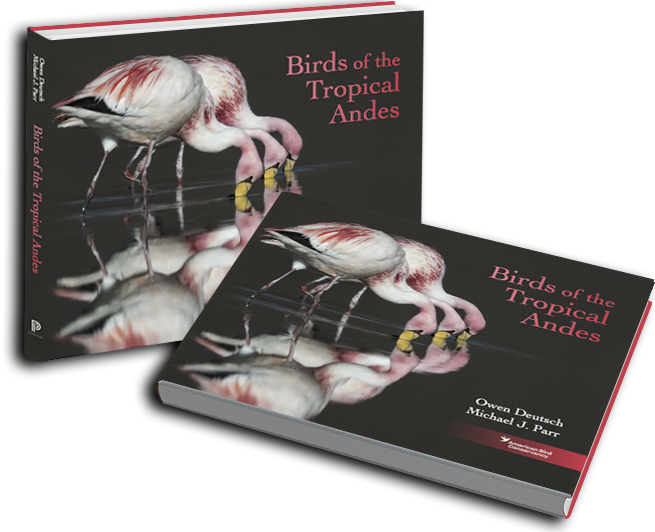
In May 2019, Owen and Mike Parr, President of American Bird Conservancy (ABC), released their first publication, Bringing Back the Birds. More than just a coffee-table book, this visually stunning call to action featured essays from several notable contributors united in their mission to highlight the urgency of bird conservation.

Now, six years later, Owen and Mike have reunited to explore a stunning yet fragile avian ecosystem in a new book, coming July 8th, The Birds of the Tropical Andes published by Princeton Press.
The Andes is the world’s longest continental mountain range, stretching over 5,500 miles from Venezuela to Argentina. As the title suggests, the focus of Birds of the Tropical Andes is specifically on the upper and central regions, an ecologically rich and diverse ecosystem that includes some of the world’s most extraordinary bird habitats. The book’s attention to this specific zone highlights the unique adaptations of birds to be found there, many of which are nowhere else on Earth. This extraordinary landscape is a birder’s heaven-on-earth, where life lists are completed and nemesis birds are finally seen. Whether seeking out the soaring Andean Condor, any of the multi-hued tanagers, just one of the 140 hummingbird species, or perhaps even the elusive Andean Cock-of-the-Rock, the Tropical Andes deserve to be on everyone’s list of birding destinations.

The region’s steep gradients naturally fragment habitats, meaning that the very factors that make the Andes a haven for birds also contribute to population fragility, often isolating species in high-altitude pockets. The Blue-throated Hillstar is a hummingbird that inhabits just a few square kilometers on one mountain in southwestern Ecuador and was only discovered in 2017. Therefore, even small-scale habitat destruction can be catastrophic. Deforestation, agriculture, mining, and infrastructure projects due to an ever-expanding human population continue to encroach on critical bird habitats, while climate change adds further pressure, forcing species into ever-shrinking ranges.
Despite these threats, dedicated conservation efforts are making a difference. Organizations like the ABC and local environmental groups whose work is detailed in the book all battle tirelessly to protect Andean ecosystems, but awareness and funding remain crucial. Birds of the Tropical Andes aims to bring global attention to this extraordinary region and its avian inhabitants, much as Bringing Back the Birds did before it.

Conceived during a trip by the two friends to the region in 2023, Owen and Mike’s book follows a structured journey through four major ecological zones, offering readers a “virtual transect” of the Tropical Andes from west to east. Beginning with the Pacific Slope and Western Andes and through the Colombian north, then into the High Andes across plateaus and beside glacial lakes before descending into Cloud Forests on the East Slope and down onto the dry foothills beyond.
Each section is divided into subchapters detailing biogeography, bird diversity, conservation challenges, and prime birding and photography locations. With a foreword by renowned ornithologist Alvaro Jaramillo and over 260 of Owen’s breathtaking photographs, the book is a visual and educational celebration of Andean birdlife.

Over the next few weeks, we will delve deeper into the book’s content through a series of blog articles, highlighting key aspects of this remarkable ecosystem, Owen and Mike’s experiences while there, focusing on both rare and understated species to be found there, as well as sharing images that did and didn’t quite make the final cut. If those photos didn’t make it, just imagine the ones that did!
Like thousands of ecosystems the world over, the Tropical Andes are at a critical juncture. The Cornell Laboratory of Ornithology has just released the 2025 State of the Birds Report, which sadly shows that the shocking losses brought to the world’s attention by the 2019 “3 billion birds” report are continuing. Without immediate conservation efforts, many species will struggle to survive in the coming decades, and even just one species becoming extinct is one too many.

By bringing attention to not only the beauty but also the fragility of this incredible environment and the sheer avian diversity it supports, Birds of the Tropical Andes aims to serve as a celebration; a travel brochure; an educational tool; a spotlight on diligent conservation organizations; and a warning, a reminder that these remarkable birds need our protection through our awareness now more than ever.


